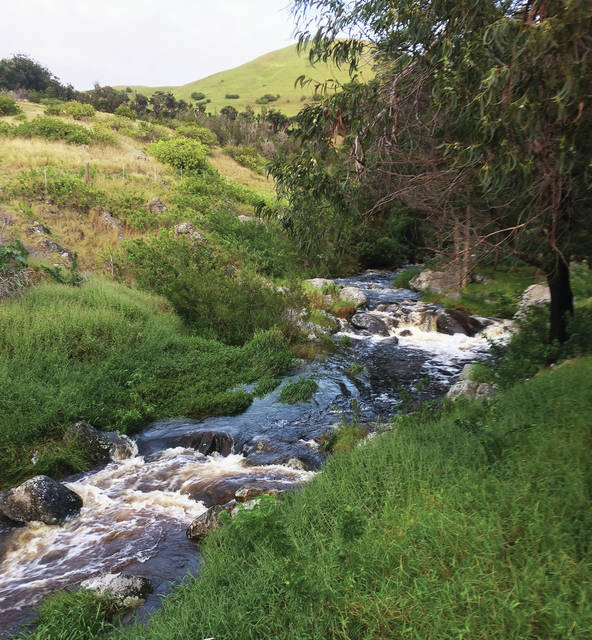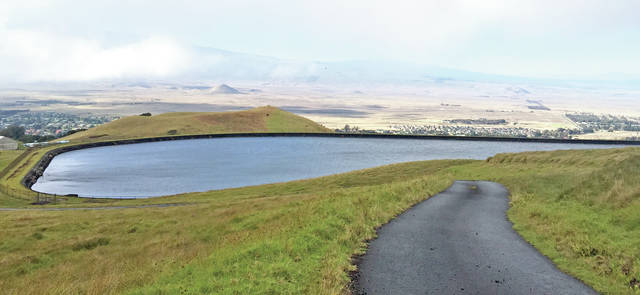WAIMEA — Tucked between Buster Brown and Puu Ki on Kohala Mountain sit two working reservoirs that support approximately 4,000 service connections in Waimea, Ahualoa, upper portions of Kalopa, Pohakea and Waiemi subdivision above Kawaihae.
WAIMEA — Tucked between Buster Brown and Puu Ki on Kohala Mountain sit two working reservoirs that support approximately 4,000 service connections in Waimea, Ahualoa, upper portions of Kalopa, Pohakea and Waiemi subdivision above Kawaihae.
The surface water comes from two sources: Waikoloa Stream, which reaches the base of Kohala Mountain behind KTA at Waimea Center, and Kohakohau Stream that runs behind Anna Ranch, according to William O’Neil, Jr., water service district supervisor at the Department of Water Supply’s Waimea office. Water from both streams is diverted to the raw water storage reservoirs and treated at the Waimea treatment facility above town.
Of the 4,000 service connections, 3,000 are in the Waimea area, where between 700,000-1,000,000 gallons of water are pumped to homes and businesses daily. The average U.S. household uses approximately 400 gallons of water per day or 100 gallons per person per day.
“The plant itself produces nearly 2 million gallons a day on average,” said O’Neil, who joined DWS 20 years ago.
The water system consists of both surface water sources and ground water sources.
For the water system between Mud Lane to the east and Opelo Road to the west — not including the system along Mana Road — there are two water tanks. One is located at DWS’s treatment plant facility and the other is above Pu’u Nani subdivision. There are also two wells: Waimea Well and Parker Ranch Well.
Upon treatment, the potable water is stored in the reservoirs, and from that point is distributed to customers. The groundwater sources are treated and pumped up to a 3,052-foot reservoir. Typically, there is a blend of the surface and groundwater that feeds the system, according to engineers at the DWS headquarters in Hilo.
The majority of Waimea’s original water system was built by the State of Hawaii decades ago. As areas developed, the water infrastructure expanded to increase its capacity.
“We’ve been adding and expanding over the years,” O’Neil, Jr. said. “The Waimea well has been there for approximately 10 years and the Parker Ranch well probably 15 years.”
While water restrictions haven’t reached emergency status in Waimea like North Kona, significant repairs are underway.
Two of the three Waimea reservoirs were damaged in a 2006 earthquake. Repairs continue some 11 years later.
“One has been repaired and a second is scheduled for repairs,” O’Neil, Jr. said. “DWS is working on the permits currently.”
Two other major repairs over the past two years include phase two of compliance upgrades to improve the system at the Waimea Treatment Plant. The project began in July 2015, priced at nearly $12 million.
“The original treatment plant is conventional and we’re upgrading it to a membrane treatment plant,” O’Neil Jr. said. “It will expand capacity, and produce up to 4,000,000 gallons a day. It will be finished by the end of this year.”
The second repair project began in September 2015 for the flocculation drive — used in water treatment in the conventional plant — costing nearly $550,000.
“The damage was just caused by age,” he said.
The two wells, which serve as ground water sources, are both currently under repair.
“One went down several months ago. It just malfunctioned,” O’Neil Jr. said. “It is on the mainland being fixed and should be shipped back within the next few months. The second well is back in the ground and we’re doing repairs. It should be online in a couple of weeks.”
In mid-May, residents were asked to conserve water by 10 percent.
“Both wells are currently being repaired so it was prudent to issue a conservation announcement,” Ka’iulani Matsumoto said, DWS’s information and education specialist, in an email. “Currently, there has been adequate rainfall, thus, the Waimea Water Treatment Plant has an adequate supply of water for treating and distributing at this time.”
A conservation notice was distributed to users May 12. An ad with the same information ran in West Hawaii Today May 19, a notice was sent to radio stations and other media outlets, and suggestions on how to cut back were posted on the DWS website simultaneously. But some customers are still unaware of the request.
“I don’t believe I received it,” said Edwin Goto said, a business owner in Waimea.
Craig Leong, project manager at Holo Holo Ku, has found ways to conserve water for the 42-unit development in Waimea.
“We’re only irrigating the hot spots,” he said. “The green grass hasn’t needed it. Only certain areas are burnt out.”
Agricultural users were asked to keep water usage to a minimum, irrigating only at night from 8 p.m. to 6 a.m. to reduce water loss due to evaporation and minimize water system usage during peak demand, according to the DWS website.
According to DWS, water conservation may need to continue throughout the summer in Waimea, but will be determined based on the progress of well repairs, in addition to the future rainfall amounts.


